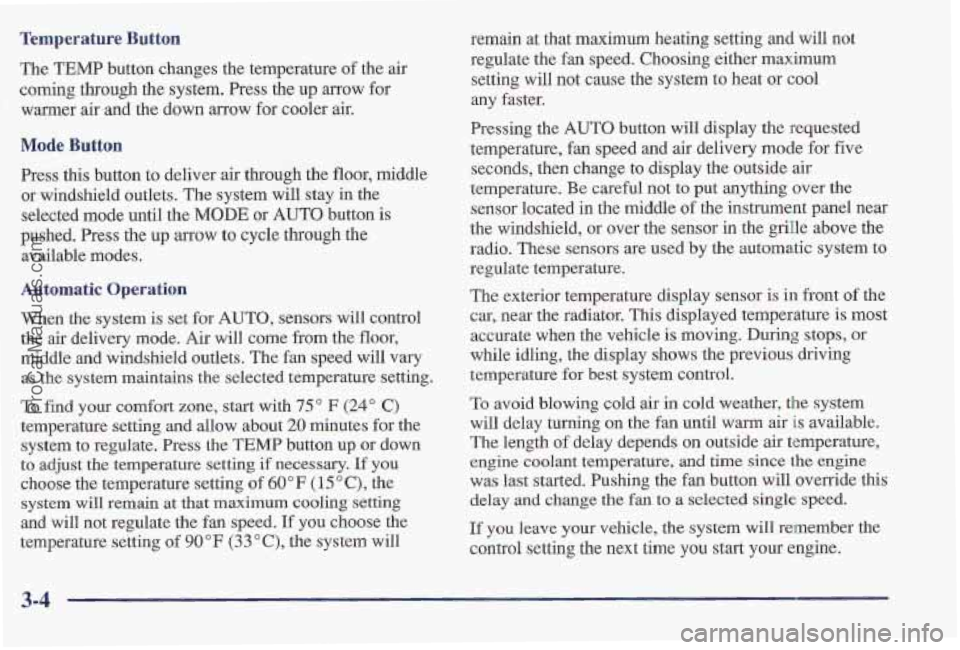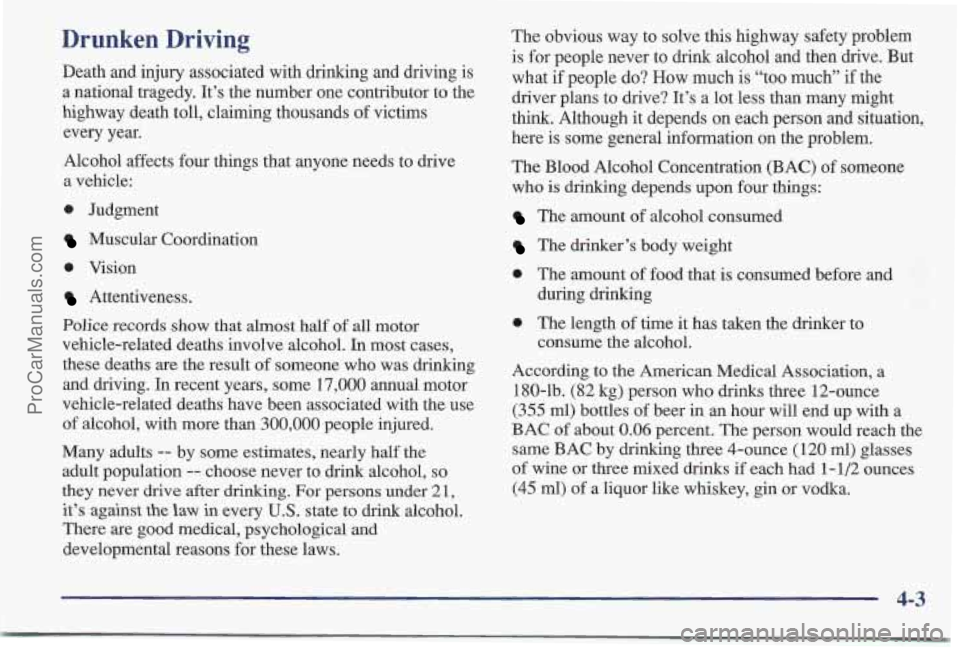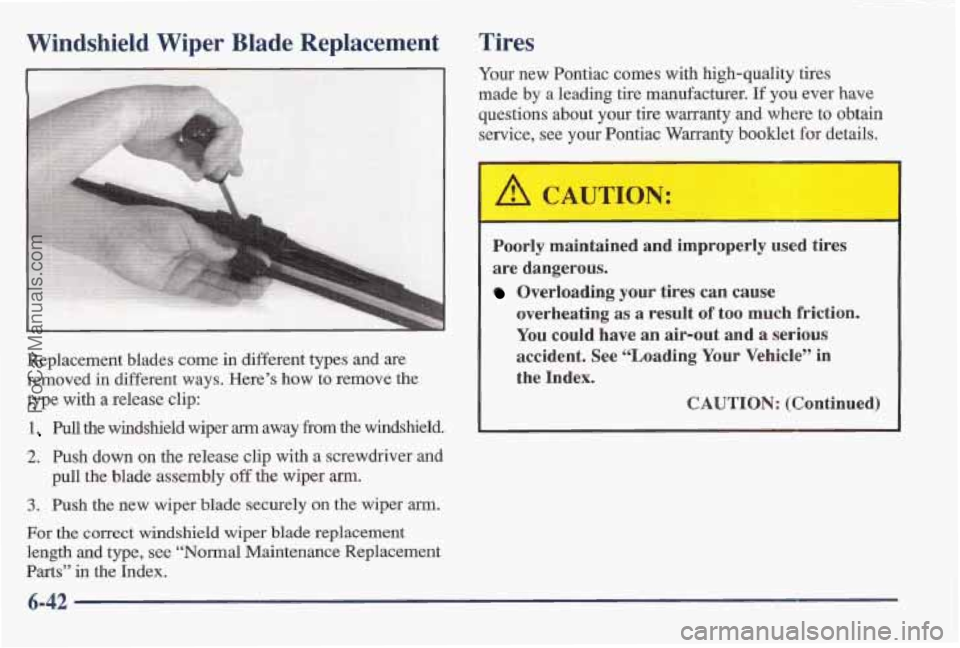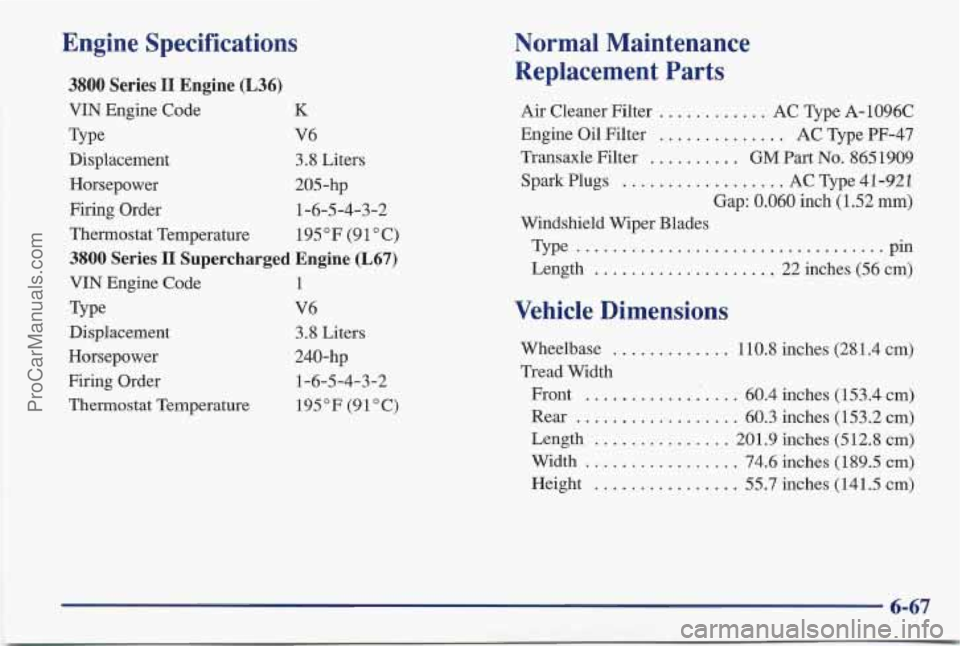1997 PONTIAC BONNEVILLE length
[x] Cancel search: lengthPage 145 of 405

Tempmerature Button
The TEMP button changes the temperature of the air
coming
through the system. Press the up arrow for
warmer air-and the down arrow for cooler air.
Mode Button
Press this button to deliver air through the floor, middle
or windshiel'd outlets. The system will stay in the
selected mode until the
MODE or AUTO button is
pushed. Press the up arrow to cycle through the
available modes.
Automatic Operation
When the system is set for AUTO, sensors will control
the air delivery mode. Air will come from the floor,
middle and windshield outlets. The fan speed will vary
as the system maintains the selected temperature setting.
To find your comfort zone, start with 75 O F (24" C)
temperature setting and allow about 20 minutes for the
system to regulate. Press the TEMP button up or down
to adjust the temperature setting if necessary. If you
choose the temperature setting of 60°F (15 O C), the
system
will remain at that maximum cooling setting
and will not regulate the fan speed.
If you choose the
temperature setting
of 90°F (33 "C), the system will remain at that maximum heating setting and will not
regulate the
fan speed. Choosing either maximum
setting will not cause the system to heat or cool
any faster.
Pressing the
AUTO button will display the requested
temperature, fan speed and
air delivery mode for five
seconds, then change to display the outside air
temperature. Be careful not
to put anything over the
sensor located in the middle of the instrument panel near
the windshield, or over the sensor in the grille above the
radio. These sensors are used by the automatic system to
regulate temperature.
The exterior temperature display sensor is in front
of the
car, near the radiator. This displayed temperature is most
accurate when the vehicle is moving. During
stops, or
while idling, the display shows the previous dsaving
temperature
for best system control.
To avoid blowing cold air in cold weather, the system
will delay turning on the fan until warm air
is available.
The length
of delay depends on outside air temperature,
engine coolant temperature,
and time since the engine
was last started. Pushing the fan button will override this
delay and change the fan to a selected single speed.
If you leave your vehicle, the system will remember the
control setting the next time you start your engine.
3-4
ProCarManuals.com
Page 176 of 405

Drunken Driving
Death and injury associated with drinking and driving is
a national tragedy. It’s the number one contributor to the
highway death toll, claiming thousands of victims
every year.
Alcohol affects four things that anyone needs to drive
a vehicle:
0 Judgment
Muscular Coordination
0 Vision
Attentiveness.
Police records show that almost half of all motor
vehicle-related deaths involve alcohol. In most cases,
these deaths
are the result of someone who was drinking
and driving.
In recent years, some 17,000 annual motor
vehicle-related deaths have been associated with the use
of alcohol, with more than
300,000 people injured.
Many adults
-- by some estimates, nearly half the
adult population
-- choose never to drink alcohol, so
they never drive after drinking. For persons under 21,
it’s against the law in every U.S. state to drink alcohol.
There are good medical, psychological and
developmental reasons for these laws. The
obvious way to solve this highway safety problem
is for people never to drink alcohol and then drive. But
what
if people do? How much is “too much” if the
driver plans to drive? It’s a lot less than many might
think. Although it depends on each person and situation,
here is some general information on the problem.
The Blood Alcohol Concentration (BAC)
of someone
who is drinking depends upon four things:
The amount of alcohol consumed
The drinker’s body weight
0 The amount of food that is consumed before and
during drinking
0 The length of time it has taken the drinker to
According to
the American Medical Association, a
180-lb. (82 kg) person who drinks three 12-ounce
(355 ml) bottles of beer in an hour will end up with a
BAC of about
0.06 percent. The person would reach the
same BAC by drinking three 4-ounce (120 ml) glasses
of wine or
three mixed drinks if each had 1 - 1/2 ounces
(45 ml) of a liquor like whiskey, gin
or vodka.
consume
the alcohol.
4-3
ProCarManuals.com
Page 295 of 405

Windshield Wiper Blade Replacement
Replacement blades come in different types and are
removed in different ways. Here’s how to remove the
type with a release clip:
1 Pull the windshield wiper ann away from the windshield.
2. Push down on the release clip with a screwdriver and
pull the
blade assembly off the wiper m.
3. Push the new wiper blade securely on the wiper am.
For the correct windshield wiper blade replacement
length
and type, see “Normal Maintenance Replacement
Parts” in the Index,
Tires
Your new Pontiac comes with high-quality tires
made
by a l’eading tire manufacturer. If you ever have
questions about your tire warranty and where to obtain
service,
see your Pontiac Warranty booklet for details.
Poorly maintained and improperly used tires
are dangerous.
Overloading your tires ‘can cause
overheating as a result of too much friction.
You could have an air-out and a serious
accident. See “Loading Your Vehicle” in
the Index.
CAUTION: (Continued)
6-42
ProCarManuals.com
Page 320 of 405

Engine Specifications
3800 Series I1 Engine (L36)
VIN Engine Code K
Type V6
Displacement
3.8 Liters
Horsepower 205-hp
Firing Order 1-6-5-4-3-2
Thermostat Temperature 195°F (91OC)
3800 Series I1 Supercharged Engine (L67)
VIN Engine Code 1
Type V6
Displacement 3.8
Liters
Horsepower 240-
hp
Firing Order 1-6-5-4-3-2
Thermostat Temperature 195°F (91OC)
Normal Maintenance
Replacement Parts
Air Cleaner Filter ............ AC Type A-1096C
Engine Oil Filter
.............. AC Type PF-47
Transaxle Filter
.......... GM Part No. 865 1909
Spark Plugs .................. AC Type 41-921
Gap:
0.060 inch (1.52 mm)
Windshield Wiper Blades
Type
..................................
Length .................... 22 inches (56 cm)
Pin
Vehicle Dimensions
Wheelbase ........... 110.8 inches (28 1.4 cm)
Tread Width Front
................. 60.4 inches (153.4 cm)
Rear
.................. 60.3 inches (153.2 cm)
Length
............... 201.9 inches (512.8 cm)
Height
.............. 55.7 inches (141.5 cm)
Width ........ + ........ 74.6 inches (1 89.5 cm)
6-67
ProCarManuals.com